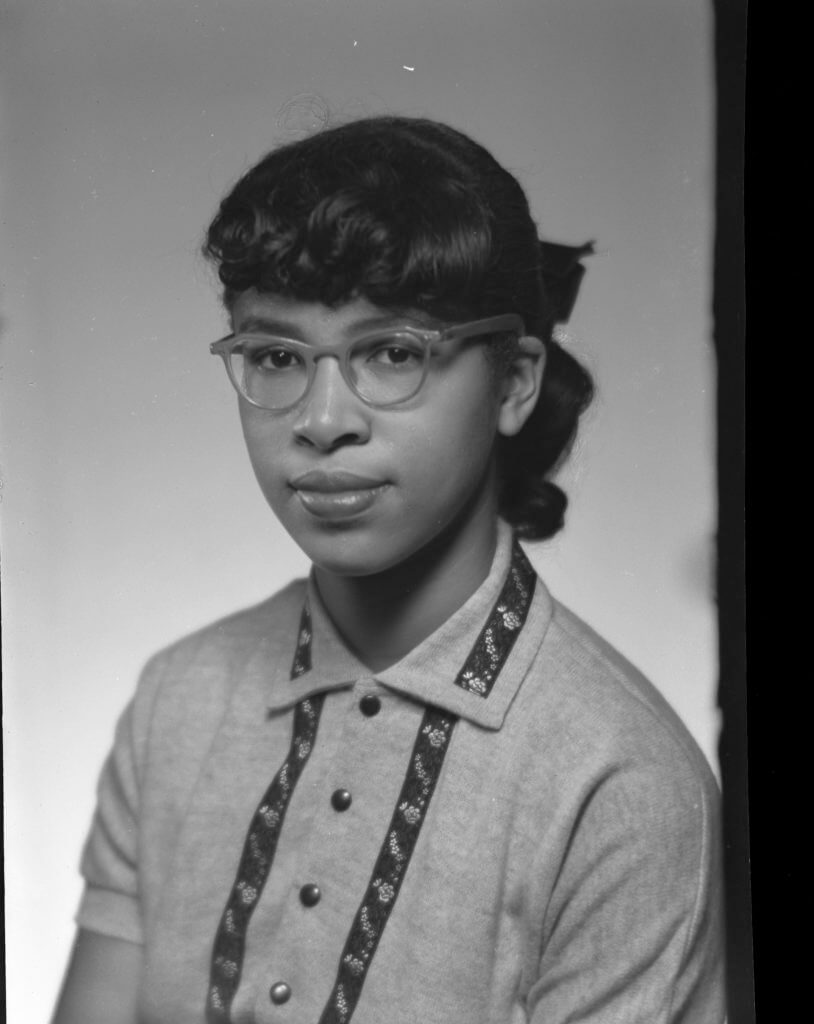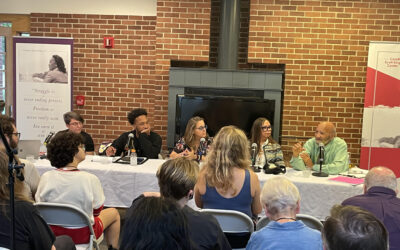Acclaimed artist Emma Amos ’58—a painter, weaver, and printmaker whose work explores the issues of power, race, identity, culture, and the struggle for freedom of expression—was born in Atlanta, GA, in 1937 and passed away on May 20th, 2020 after a battle with Alzheimer’s Disease (read Emma Amos’s obituary).
Throughout her life, Amos became involved with activism groups “that agitated for a more inclusive, equitable, and diverse art world,” writes Benjamin Sutton.
Amos became a prominent figure of “the influential but short lived Spiral Collective of Black artists as its only female member, the feminist Heresies Collective (as one of its few Black members), and the Guerrilla Girls.”
EARLY LIFE
While in kindergarten, Amos’ teacher, classmates and parents took notice of her extraordinary talent in the arts. In an interview with Al Murray for the Archives of American Art, Smithsonian Institution (October 1968), Amos recollects being in first grade. “… All the little children loved the things that I drew and I did masses of paper dolls and things. And then it got really serious and people thought, ‘oh, she can really draw’. So, they gave me things to copy… they gave me everything that was going, coloring books and things to copy.”
Amos enrolled at Antioch College in 1953 at the age of 16 after hearing from her father that he thought it was “a very forward-looking school.”
“…, it was wonderful. It’s a beautiful school, a lovely campus. You work half the year and go to school half the year. I got to work in Chicago and Washington and in New York and really expand. That’s where I got to go to galleries and museums, that’s when I really got to see the art world.”

Emma Amos in 1953
EMMA’S ANTIOCH ADVENTURE
Amos’s senior paper, dated February 17, 1958, sheds significant light on her development as an artist and person in the world. The Antioch Review published the paper in its entirety in the summer 2019 issue, “The Education of an Artist”—excerpts to follow. Her paper sheds much light on her background and her experience at Antioch College.
Antioch’s program for a liberal arts education attracted me to the school. I believed that I could get a good general education and develop a strong background in my field, Creative Arts.
My family had instilled in me the appreciation of quietude, the desire to grasp periods alone with myself, and a strict love of privacy. Antioch recognizes all of these, but the nature of the college is such that every member of the community must at some time or other abandon one or all of the three. I have felt most at ease and worked most effectively since my third year when I began to realize and feel a great need for my former self.
Other than having to make this sort of adjustment, the transition from home to Antioch was comparatively easy. I had been prepared for college all of my life and high school had only been the last step in that goal. I did not know what college meant; it was almost an end in itself. I had always wanted to draw and paint. The idea that at Antioch I could work, paint, and study “college type” things and also see my worth in relation to others- in terms of my painting and ability to work- was my basis for coming here.
As much as her paper and later life accounts demonstrate how much she valued her Antioch College education, she also had critiques of the arts program and its integration within the larger curriculum, writing, “Both the general education and field programs could be made more effective if they took more consideration of one another.” Amos craved the breadth of knowledge inherent in a liberal arts education, but was at once frustrated that she could not “gain competence” in the manner of an art school.
Under the requirements for Level I and Level II it is possible to graduate from Antioch without any knowledge of art criticism or Literature, depending on which direction the student avoiding –or neglecting-either would take. What is general education if it is not at least an understanding of the underlying principles of the major “fields of human knowledge”? What value is a higher education which does not include some basis for aesthetic criticism other than “I don’t know anything about art, but I know what I like”? If Antioch is helping to supply the learned minority of the population and only a few Antioch students know anything about art, then who buys the paintings, reads the poems, and knows anything about his contemporary and past heritage?
Because I knew my major before I came to Antioch, I was immediately exposed to the stone wall-trying to relate it to my general education courses; trying to resolve the conflict brought about by the contradiction inherent in the dual goal of general education and field proficiency as combined with Antioch.
As is the case with all Antioch students, Amos found Co-op to be formative, and transformative, exposing her to different realities of work and the world. Just one of her Co-op jobs were specific to her field of study, but each provided invaluable experience and developed a deepend sense of self-knowledge.
My job experience gives the answer to another part of the question and includes another influence. The idea that one should be one’s own advisor and boss has been a main influence from home and has been basic to my living in every community. The freedom and maturity derived from living as one’s own advisor and boss has always been a cherished possession in my family. It has validity in a community such as my own at home , where of the great numbers of Negroes, only a relative few make their livings any way other than directly from the white man, and of those few, far fewer can trace their independence back further than a generation. The job experiences which I have had show a relation to this influence.
My first job was working in the personnel department of a large department store in Chicago. There was no skill necessary, not even typing. So little activity was required of the mind that I had great difficulty in keeping my attention directed toward the keeping of records. It was my first encounter with a time clock and I learned that it could control my activities out of proportion to its duty of seeing that I put in the required number of hours. It became a part my thinking about my work, a major consideration. I was aware of the time clock and considered it as much a part of the job as the work itself. I adhered to its concept of good and was firmly aware of its (and the store’s) attitude toward me: a statistic. The fact of being a statistic was firmly driven home to me because I had to handle hundreds of people’s basic statistics. I felt it my duty to like them, if only by name and sales number, feel happy about their raises in pay and sad when they were recorded as asking for advances in pay. I was going to be human even if nothing else was. This was my first real job and I was surprised to find I had no difficulty in working for such a big organization. I was a statistic under a direction so impersonal and definite that my performance could only correspond in its thoroughness and unimaginativeness.
My next job was with a similar large organization, the New York Public Library; however, there was a great difference. I was a member of a technical group whose interest was not in a tangible product (although books could be classed as tangibles) but, in the activity of its product and in its effects. To be more explicit I was a member of a troupe of bringers of the mountain to Mohammad: the Bronx Bookmobile. We travelled to all the sections of the Bronx not within access of a stationary library. I had a head librarian who cared about “her” employees as they affected “her” work. She was pushing for a promotion and this made everything very interesting. “Never give up the ship.” It was summer and we martyred ourselves inside the truck at 104 degrees when all other libraries closed because of extreme temperatures.
The Chicago episode was almost repeated in Washington, working for the census Bureau. The government! There was an air of dedication to something, I refrain from saying what. There were great attempts at making relations personal. We talked about our immediate bosses, about who came and went and how and why. We were made to feel more human by Univac [the acronym UNIVAC stood for UNIVersal Automatic Computer], our mechanical brain. Univac could never make mistakes and it is human to err, so….The feeling of being in a huge machine was always present but it was a warm, well oiled (in most places) old machine.
The spring and summer before I went to Europe I worked for my father at home. There I really got a close look at what a private business is like. It is a comfortable and dangerously responsible position being one’s own boss. It carries with it the balance of independence and maturity which I have been brought up to appreciate and learned to seek in previous job experience. There is a possibility that I shall have some part in the operation of the drug store. It is truly a life consuming business, the hours are long and the work physically wearing. The returns are great in terms of money and position and have compensated almost completely for my parent’s inability to have an outside life. It is an institution in our community. My grandfather was the first Negro to own and operate his own pharmacy in Georgia and my father has operated his own business for thirty-five years.
My last job was working on campus as assistant in the Creative Arts department. Just being around the studios and handling the materials is incentive to work. My schedule was arranged so that I got to work on my own every day. I worked in the department as assistant every day until 4:30 with the additional hours spent helping to arrange shows, etc. on the weekends. I taught a drawing and painting workshop on Monday nights, a weaving workshop on Thursday. I took a workshop on Monday nights, a weaving workshop on Thursday. I took a workshop in design on Wednesday nights and a drawing workshop on Sunday nights, and painted every weekend.
During her studies at Antioch, Emma spent one year abroad—which she notes was the “single most rewarding experience” of her education—studying painting, weaving and printmaking at London’s Central School of Art and regularly attending lectures at the London School of Economics. Amos wrote that she “found in England is the source of confidence in myself which I never found” anywhere else. While she cites in her paper several experiences which led to this increase in confidence, she details what she calls a “more intangible” reason:
I have been a Negro all my life (an obvious statement, though not as ridiculous as it sounds) and the fact of it has never bothered me at all. Being from Atlanta, Georgia has conditioned and insulated me against any real disturbances. It was not until I went to Europe that I was made aware of the effect of this condition and insulation, or that I had apparently never been allowed to uncondition, even at Antioch. My first discovery was that of being an American. It is rather odd to realize that here in America I am a Negro. This “being an American” was a change of emphasis which gave me more of a chance to know and be me. Although I seemed to be considered an unusual and strange entity in most of the countries in which I traveled, it was for a novel reason. As I might have been stared at with hostility because I was American by people who have preconceived ideas of what Americans are, and as it might happen in America where I am a Negro; I was stared at out of curiosity and as an individual.
Amos also reflects on the experience in London affirming her desire to pursue art as her chosen vocation.
I believe that only painting will give me the realization of my life and studies. I cannot anticipate the effect of the constant shifting of surroundings, values, emphases, and pressures; I can anticipate this ebb and flow as a necessary part of being alive. This is the element of the unknown which makes life for me exciting and a challenge.
AFTER ANTIOCH
Emma returned to the Central School of Art in London for a degree in etching, which she received in 1959. A year later, she had her first solo exhibition in Atlanta but felt hindered by the slow-moving art scene, and moved to New York in 1961.
In New York, Amos was faced with rejection after rejection due to her race, age, and gender. She was also denied teaching jobs because she was not perceived to be a mature artist, and was denied entry to the East Hampton art scene because this was considered a “man’s scene.” And so, she began working as a textile designer and translated her art into carpets.
In 1964, Emma began a master’s program at New York University where she studied art education. That same year, Emma became a member of the New York-based African American art collective Spiral. She became the group’s youngest and only female member.
In the 1970s she was an editor at Heresies, a feminist journal that published texts by Ana Mendieta, Adrian Piper and others, and after their founding in 1985 she became a member of the Guerrilla Girls, the hugely influential group of women artists who exposed misogyny in the art world.
It’s hard to date exactly when Amos joined the Guerrilla Girls, as its members are anonymous, but in a 2011 oral history interview with the Smithsonian Institution’s Archives of American Art, she mentioned being “a member of a very famous clandestine women’s group that worked at night and did not ever go out without masks on our faces,” and her gallery confirmed that she was referring to the Guerrilla Girls.
Her painting and printmaking incorporated a dizzying range of references to white hegemony, racism, sexism, craft and the Black female body. “If there is one thing made clear by these feverish amalgams of painted and printed images,” wrote Vivien Raynor in a New York Times review of Amos’s 1995 solo exhibition at the Montclair Art Museum, “it is that the artist’s gift is for depicting, with disturbing accuracy, chaos that is irreversible.”
Like many female artists and artists of color who came of age alongside her, Amos drew major critical attention relatively late in life, despite decades of exhibitions. Her recent inclusion in traveling museum exhibitions like “Soul of a Nation: Art in the Age of Black Power” and “We Wanted a Revolution: Black Radical Women 1965-1985” brought her a surge in popularity.
Emma taught at Rutgers University’s Mason Gross School of Art from 1980 until her retirement in 2005. After her retirement, Emma continued to create artworks and exhibit these internationally. Her paintings have become a permanent collection at the Museum of Modern Art, the Studio Museum of Harlem, the Whitney Museum of American Art, the Brooklyn Museum in New York, and the Cleveland Museum of Art. In 2021, the state of Georgia will open a retrospective of the artist’s work at the Georgia Museum of Art in Athens.
SOURCES:
Antiochiana — the Antioch College Archives
ARTFORUM
Smithsonian Archives of American Art
WeBuyBlack



